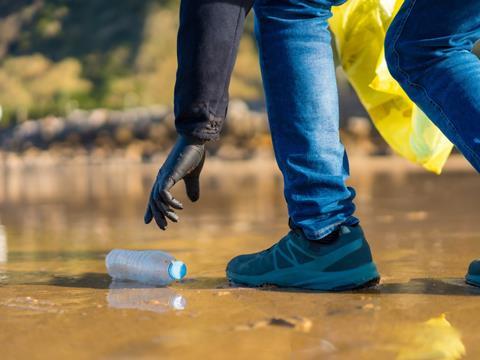
As INC-3 approaches, the Plastic Footprint Network (PFN), a coalition of global corporations and NGOs, has unveiled a unified methodology to measure plastic footprints and push back against plastic pollution worldwide.
The Plastic Footprint Network, or PFN, was convened in 2022 by EA Earth Action, a Swiss research consultancy aspiring to bring together worldwide efforts to develop a harmonized framework, rooted in science, for ‘measuring and mitigating’ plastic pollution. It consists of thirty-five global organizations including South Pole, World Business Council for Sustainable Development (WBCSD), Global Plastic Action Partnership (GPAP), and WWF.
The coalition has been developing a new methodology with which to undertake plastic footprint assessments while aligning with the current framework for assessing and reducing carbon footprint – intending to help global organizations accurately gauge their plastic footprint, or the impact of their plastic use on the environment.
This methodology assesses plastic leakage for macro- and micro-plastics and enables outcome-based plastic mitigation by evaluating the effectiveness of proposed solutions. It was developed in collaboration with a committee of experts and academics and has been compared to the Greenhouse Gas Protocol, which is commonly used by organizations, governments, and NGOs to account for their greenhouse gas emissions.
Released ahead of next week’s negotiations surrounding a UN Plastics Treaty in Nairobi, the methodology aims to meet the requirements of UNEP’s Zero Draft by “ensur[ing] mandatory disclosures from businesses, including the financial sector, on their activities and financial flows from all sources related to plastic pollution and related sustainable finance practices”.
Another proposed option is to put a “governing body” in charge of reporting; this organization would “evaluate the effectiveness of this instrument” and “decide upon the timing and format of the reporting to be followed by the parties, taking into account the desirability of coordinating reporting with relevant international instruments and organisations.”
However, PFN pushes for the incorporation of mandatory disclosure and its centralization via the proposed UN Treaty, with plastic footprinting used to standardize the disclosed information. Its Vision Statement further develops its view of setting ambitious plastic pollution targets in line with the UN Treaty and scientific expertise.
“If we are to turn the tide of plastic pollution, both industry and government must fully address their plastic footprint,” said Sarah Perreard, co-CEO, EA Earth Action & Plastic Footprint Network. “This methodology provides direction to ensure companies are empowered to understand the plastic leakage in their supply chains and take action.
“I now urge the delegates present at negotiations in Nairobi to take note of what has worked when standardizing carbon footprint measurements, and ensure that true and lasting plastic pollution mitigation is delivered, while supporting a transition to circular models for global plastic use. This will help deliver a global framework that tackles plastic pollution at every stage of its lifecycle and steer the World away from the current crisis we experience.”
“In the midst of a plastic pollution crisis, both industry and government action must be accelerated,” John Duncan, global initiative lead at WWF, continued. “For this change to occur at the rate which is required, robust corporate accountability measures and global targets founded in harmonized and transparent measurement are urgently needed. The Global Plastics Treaty presents a once-in-a-lifetime opportunity to build agreement on these elements.”
Oliver Tanquery, associate director, Ocean Health, CDP, added: “It takes significant work to build a robust, consistent and credible framework for corporate reporting, as CDP has learned in its decades of experience in this space.
“CDP congratulates the Plastic Footprint Network for its collaborative efforts to establish a methodology for plastic footprint calculation and to identify key elements for a corporate accountability framework, both of which will be central to the implementation and monitoring of an effective Global Plastics Treaty. CDP will engage proactively with the network to bring its disclosure-specific expertise to the process, and will advocate for alignment, collaboration and simplification of initiatives working in this space.”
In similar news, Plastics Europe and its members have backed a ‘Plastics Transition’ roadmap in pursuit of net zero emissions, circularity, and sustainable material consumption among the European plastics industry.
Riley McCormack, president and CEO of Digimarc, has also encouraged negotiators to ‘seize this historic opportunity and adopt language requiring digital marking of plastic packaging’ in the Global Plastics Treaty.
On the other hand, the Ellen MacArthur Foundation warns in a new paper that the global fight against plastic pollution remains ‘off track’ and calls for ‘tougher measures’ to make more substantial progress.
If you liked this article, you might also enjoy:
The L’Oréal approach to packaging sustainability
What steps is Apple taking to make its packaging more sustainable?
How did Brazil achieve its 100% aluminium can recycling rate – and can it be replicated in the EU?
Experts have their say on the EU’s Packaging and Packaging Waste Directive revisions
Also, if you’re interested in packaging sustainability, you will want to attend our Sustainable Packaging Summit in Amsterdam on 14-15 November. The Summit brings together leaders and pioneers from across the industry to align strategically, learn, network, and create a critical mass to accelerate change. You can learn more by clicking here, and you can buy a ticket to attend here.











No comments yet